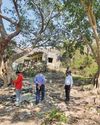Essayer OR - Gratuit
A river lost
Down To Earth
|October 16, 2024
Unchecked discharge of industrial effluents and inadequate sewage treatment facilities have turned the Hindon water toxic. ROHINI KRISHNAMURTHY tracks the river's journey though seven Uttar Pradesh districts, starting from its origin in Saharanpur
-

WHEN DIVYA Shikhawal developed a fever in June 2023, her parents consulted a private hospital near their village, Shimlana Mu. But the doctors were unable to diagnose the ailment. With her blood platelet count plummeting, Shikhawal’s parents, who run a grocery shop in the village, located in Uttar Pradesh’s Saharanpur district, took her to aiims Delhi, where tests revealed that the 17-year-old had blood cancer.
While Shikhawal survived, Satpal Singh, a sugarcane farmer in the same village, had to deal with a loss. Four years ago, his wife died due to liver cancer when she was 40 years old. Singh says the village has seen more than 100 cancer deaths in the last decade. With a population of about 7,700, as per the 2011 census, the village’s cancer incidence rate is 1.3 per cent, while the average incidence of cancer in India in 2022, as per a paper published the same year in Indian Journal of Medical Research, was roughly seven times lower at 0.1 per cent .
Both Singh and the Shikhawal family say that the source of their health problems is the Hindon, a 400-km rain-fed river emerging from the Shivalik Hills in Saharanpur. “Factories in Saharanpur release effluents into the river, especially during the rains, which contaminate the groundwater that we rely on for drinking and for all our domestic needs,” says Singh. Households in Shimlana Mu do not have piped water connection and most use hand pumps. A 2007 study by Janhit Foundation, a non-profit based in Meerut district, found lead and chromium in the village groundwater (see ‘Research so far’, p19). When Down To Earth (dte) visited the village in September, roads were being dug to instal pipes.
Cette histoire est tirée de l'édition October 16, 2024 de Down To Earth.
Abonnez-vous à Magzter GOLD pour accéder à des milliers d'histoires premium sélectionnées et à plus de 9 000 magazines et journaux.
Déjà abonné ? Se connecter
PLUS D'HISTOIRES DE Down To Earth
Down To Earth
China backs open-source AI to circumvent US checks
CHINA IS challenging global artificial intelligence (AI) dynamics by releasing powerful, open-source models developed by its tech giants, including Baidu, Alibaba, Tencent and the startup DeepSeek. This strategic move aims to circumvent US export restrictions on advanced chips and to foster rapid innovation within its AI sector.
1 min
July 01, 2025

Down To Earth
Yet another washout
UN Ocean Conference sees limited progress, as SDG 14 remains the least funded global goal despite pledges and finance talks
6 mins
July 01, 2025
Down To Earth
WHAT IS THE DEBT AND CLIMATE LINK?
Over half of the low- and middle-income nations with high climate vulnerability are either already in debt distress or at high risk of it
5 mins
July 01, 2025
Down To Earth
India rolls out guidelines for expired medicine
ON MAY 26, India's Central Drugs Standard Control Organisation issued guidelines for the safe disposal of expired and unused medicines to drug controllers in all states and Union Territories.
1 min
July 01, 2025
Down To Earth
TAME THE TRADE
Strengthen wildlife protection laws to combat illegal hunting and trade of exotic and threatened species in India
4 mins
July 01, 2025
Down To Earth
13 nations battle hunger emergencies
THE WORLD stands on the brink of yet another humanitarian disaster with at least 13 countries facing escalating hunger emergencies-five of which are on the verge of famine.
1 min
July 01, 2025

Down To Earth
HOW LARGE IS SOVEREIGN DEBT?
Its burden on developing countries is growing twice as fast as on developed countries
4 mins
July 01, 2025

Down To Earth
A grove revived
It took 15 years for residents of Rajasthan's Sirawas village to bring to life a severely degraded sacred grove, an initiative that has triggered replicative efforts across the region
4 mins
July 01, 2025
Down To Earth
WHY SOVEREIGN DEBT RISING IN DEVELOPING WORLD?
Biased sovereign credit ratings and steep interest rates are at work
4 mins
July 01, 2025
Down To Earth
WHAT ARE THE SPILLOVER IMPACTS OF EXTERNAL DEBT?
Development priorities put on back burner
2 mins
July 01, 2025
